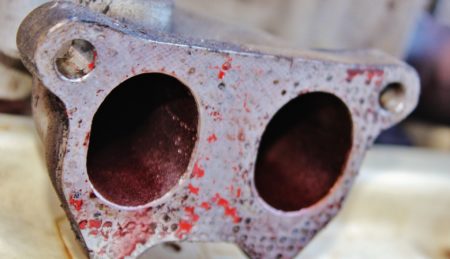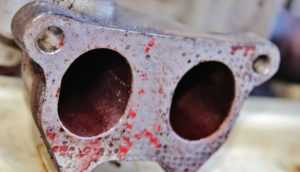 Intake manifolds…the gateway to the engine…the place where it all begins. For those of you that are new to this, the intake manifold’s purpose is to provide an entry path for the fuel mixture of both air and fuel to enter the engine. These are typically cast aluminum pieces with curved runners to each cylinder. Newer versions are now molded polymer construction, allowing more complex designs for improved airflow and also less weight.
Intake manifolds…the gateway to the engine…the place where it all begins. For those of you that are new to this, the intake manifold’s purpose is to provide an entry path for the fuel mixture of both air and fuel to enter the engine. These are typically cast aluminum pieces with curved runners to each cylinder. Newer versions are now molded polymer construction, allowing more complex designs for improved airflow and also less weight.
If your intake manifold gasket isn’t doing its job, you are going to see a poor performing engine all around. A flange that isn’t properly sealed will likely allow additional air into the cylinder, causing poor performance. Worse failures can include fluid leakage, where coolant can leak through the gasket either internally into the crankcase, or externally to the ground. As with any seal point, you need to fully understand the environment in order to make a proper gasket material selection. Below are the considerations you need to be aware of when selecting such materials.
What To Pay Attention To
1. Fluid Compatibility
Is your gasket compatible with the designated fluids? Initially, make sure that the material will not be degraded by contact with the fluids. This will make sure the integrity of the material will not be compromised.
2. Temperature Capability
Confirm that the gasket material is designed to survive the temperatures the intake manifold will see (some have coolant ports and some have EGR exhaust ports, requiring better materials). Also, with high temperatures can come expansion and contraction. (see #4 below) Is your gasket material robust enough to handle the scrubbing?
3. Conformance
Find a material that best meets the compressibility / recovery / creep-relaxation requirements that you need. Some joints require thicker gaskets to overcome variations in the gap. This can be achieved with composite laminates. All gasket materials perform differently, and you can see drastically different results from materials that you might perceive to be similar based on these properties.
4. Release or Slip Tolerance
Consider whether you need an anti-stick coating for easier removal. Facing materials tend to stick, particularly with heat and fluid exposure. Also, if there is a lot of expansion/contraction due thermal conditions, an anti-stick coating will protect the material allowing it to slip without destruction.
Making Your Decision
In general, gasket materials that are designed to seal fluids tend to perform well in the intake manifold. Many cast metal intakes have flat flanges, providing the opportunity for a typical die-cut gasket to do the job. Be sure to select the right material for the conditions to get the best long-term performance. If you have any questions about which materials best meet the above conditions, please don’t hesitate to contact your trusted gasket material supplier.
What issues do you have with your intake manifold gaskets? If you are interested in subscribing to Sealed-In’s blog posts, email sales@mtigasket.com.
Metal Tech offers our CS 794 specifically for intake applications. It features a performance facing with good fluid and temperature resistance applied to the Corseal core for a mechanical bond. MTI also offers various solid core grades, such as SB 643, in different thicknesses for various intake manifold applications. These grades are typically coated with the TechCoat anti-stick coating to allow for slippage due to thermal motion, and also a cleaner release. The CS 830 and CS 920 products can also be considered for intakes.

Intake manifolds…the gateway to the engine…the place where it all begins. For those of you that are new to this, the intake manifold’s purpose is to provide an entry path for the fuel mixture of both air and fuel to enter the engine. These are typically cast aluminum pieces with curved runners to each cylinder. Newer versions are now molded polymer construction, allowing more complex designs for improved airflow and also less weight.
If your intake manifold gasket isn’t doing its job, you are going to see a poor performing engine all around. A flange that isn’t properly sealed will likely allow additional air into the cylinder, causing poor performance. Worse failures can include fluid leakage, where coolant can leak through the gasket either internally into the crankcase, or externally to the ground. As with any seal point, you need to fully understand the environment in order to make a proper gasket material selection. Below are the considerations you need to be aware of when selecting such materials.
What To Pay Attention To
1. Fluid Compatibility
Is your gasket compatible with the designated fluids? Initially, make sure that the material will not be degraded by contact with the fluids. This will make sure the integrity of the material will not be compromised.
2. Temperature Capability
Confirm that the gasket material is designed to survive the temperatures the intake manifold will see (some have coolant ports and some have EGR exhaust ports, requiring better materials). Also, with high temperatures can come expansion and contraction. (see #4 below) Is your gasket material robust enough to handle the scrubbing?
3. Conformance
Find a material that best meets the compressibility / recovery / creep-relaxation requirements that you need. Some joints require thicker gaskets to overcome variations in the gap. This can be achieved with composite laminates. All gasket materials perform differently, and you can see drastically different results from materials that you might perceive to be similar based on these properties.
4. Release or Slip Tolerance
Consider whether you need an anti-stick coating for easier removal. Facing materials tend to stick, particularly with heat and fluid exposure. Also, if there is a lot of expansion/contraction due thermal conditions, an anti-stick coating will protect the material allowing it to slip without destruction.
Making Your Decision
In general, gasket materials that are designed to seal fluids tend to perform well in the intake manifold. Many cast metal intakes have flat flanges, providing the opportunity for a typical die-cut gasket to do the job. Be sure to select the right material for the conditions to get the best long-term performance. If you have any questions about which materials best meet the above conditions, please don’t hesitate to contact your trusted gasket material supplier.
What issues do you have with your intake manifold gaskets? If you are interested in subscribing to Sealed-In’s blog posts, email sales@mtigasket.com.
Metal Tech offers our CS 794 specifically for intake applications. It features a performance facing with good fluid and temperature resistance applied to the Corseal core for a mechanical bond. MTI also offers various solid core grades, such as SB 643, in different thicknesses for various intake manifold applications. These grades are typically coated with the TechCoat anti-stick coating to allow for slippage due to thermal motion, and also a cleaner release. The CS 830 and CS 920 products can also be considered for intakes.

Intake manifolds…the gateway to the engine…the place where it all begins. For those of you that are new to this, the intake manifold’s purpose is to provide an entry path for the fuel mixture of both air and fuel to enter the engine. These are typically cast aluminum pieces with curved runners to each cylinder. Newer versions are now molded polymer construction, allowing more complex designs for improved airflow and also less weight.
If your intake manifold gasket isn’t doing its job, you are going to see a poor performing engine all around. A flange that isn’t properly sealed will likely allow additional air into the cylinder, causing poor performance. Worse failures can include fluid leakage, where coolant can leak through the gasket either internally into the crankcase, or externally to the ground. As with any seal point, you need to fully understand the environment in order to make a proper gasket material selection. Below are the considerations you need to be aware of when selecting such materials.
What To Pay Attention To
1. Fluid Compatibility
Is your gasket compatible with the designated fluids? Initially, make sure that the material will not be degraded by contact with the fluids. This will make sure the integrity of the material will not be compromised.
2. Temperature Capability
Confirm that the gasket material is designed to survive the temperatures the intake manifold will see (some have coolant ports and some have EGR exhaust ports, requiring better materials). Also, with high temperatures can come expansion and contraction. (see #4 below) Is your gasket material robust enough to handle the scrubbing?
3. Conformance
Find a material that best meets the compressibility / recovery / creep-relaxation requirements that you need. Some joints require thicker gaskets to overcome variations in the gap. This can be achieved with composite laminates. All gasket materials perform differently, and you can see drastically different results from materials that you might perceive to be similar based on these properties.
4. Release or Slip Tolerance
Consider whether you need an anti-stick coating for easier removal. Facing materials tend to stick, particularly with heat and fluid exposure. Also, if there is a lot of expansion/contraction due thermal conditions, an anti-stick coating will protect the material allowing it to slip without destruction.
Making Your Decision
In general, gasket materials that are designed to seal fluids tend to perform well in the intake manifold. Many cast metal intakes have flat flanges, providing the opportunity for a typical die-cut gasket to do the job. Be sure to select the right material for the conditions to get the best long-term performance. If you have any questions about which materials best meet the above conditions, please don’t hesitate to contact your trusted gasket material supplier.
What issues do you have with your intake manifold gaskets? If you are interested in subscribing to Sealed-In’s blog posts, email sales@mtigasket.com.
Metal Tech offers our CS 794 specifically for intake applications. It features a performance facing with good fluid and temperature resistance applied to the Corseal core for a mechanical bond. MTI also offers various solid core grades, such as SB 643, in different thicknesses for various intake manifold applications. These grades are typically coated with the TechCoat anti-stick coating to allow for slippage due to thermal motion, and also a cleaner release. The CS 830 and CS 920 products can also be considered for intakes.
